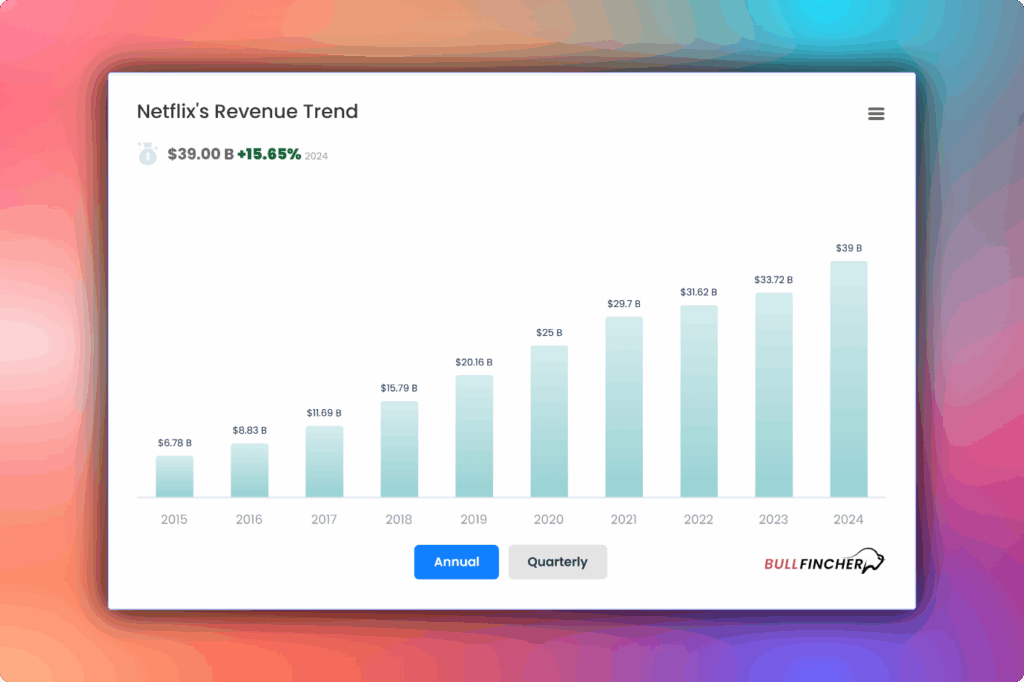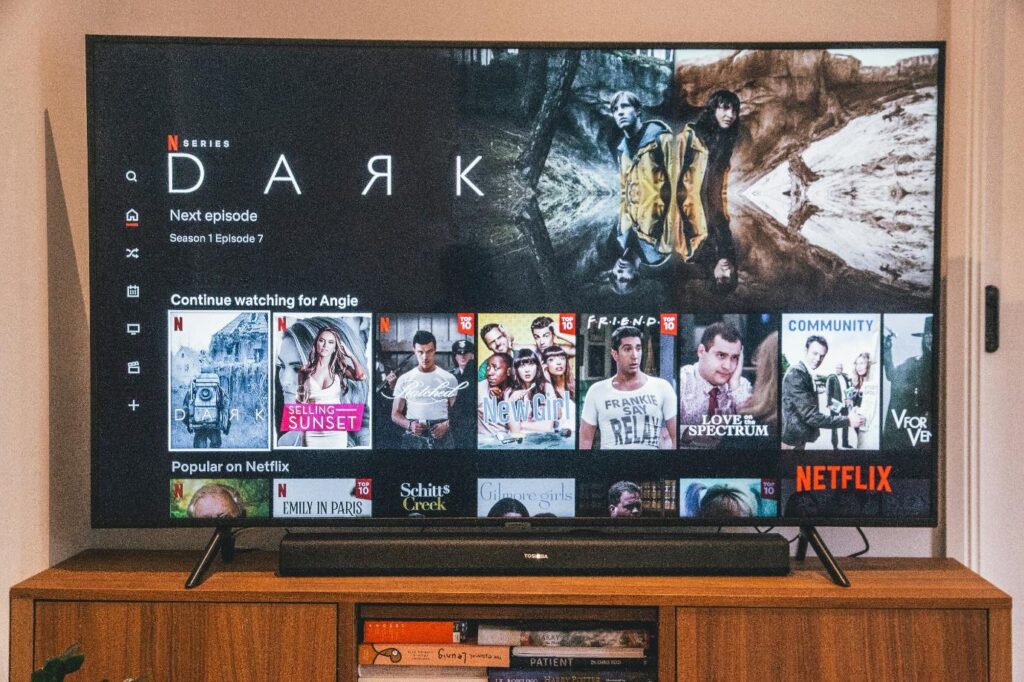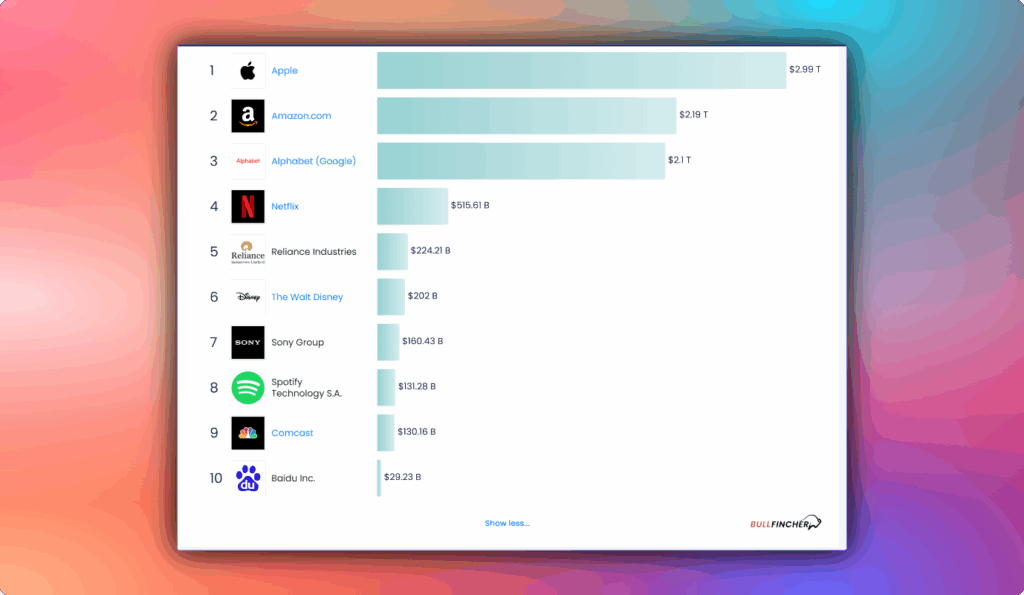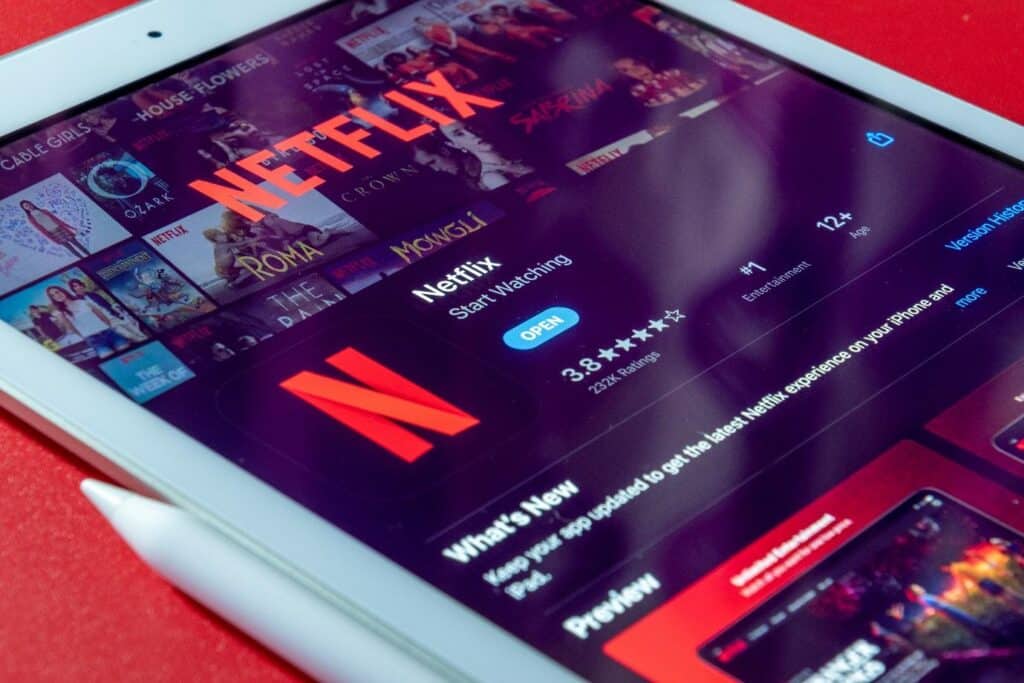Company: Netflix, Inc.
CEO: Greg Peters
Year founded: 1997
Headquarter: Los Gatos, California, USA
Number of Employees : 14,000
Type: Public
Ticker Symbol: NFLX
Market Cap (Apr 2025): $449.93 Billion
Annual Revenue (FY2024): $39 Billion
Profit | Net Income (FY2024): $8.71 Billion
Products & Services: Online Streaming Platform | On-demand Video and Audio Content | Live Sports & Entertainment Programs | Streaming Apps | Gaming | Entertainment Services
Competitors: Amazon Prime Video | Disney+ | Hulu | HBO Max | Peacock | Apple TV+ | YouTube | Paramount+ | Sling TV | Showtime | 21st Century Fox | WarnerMedia | DIRECTV | CrunchyRoll | Play Station Vue
Fun Fact:
Did you know? Netflix entertains over half a billion people in over 190 countries and 50 languages.
Netflix is a leading subscription video-on-demand (SVOD) streaming service established by Reed Hastings and Marc Randolph in Scotts Valley, California. It distributes original and acquired films and television shows across genres in over 190 countries and 50 languages. Netflix’s marketing strategy contributes to the platform’s global leadership by differentiating it from alternatives. In FY2024, Netflix generated $39 billion in annual revenue, up 16% from FY2023. Its net income increased by 61% to $8.71 billion, while its profit margin rose to 22% from 16%. [1]

Image source: Bullfincher.io
To understand Netflix’s secret to success, here is a comprehensive analysis of its marketing strategy:
Netflix’s Target Market Overview
Netflix’s target market cuts across demographics, interests, and regions. Its content library offers movies, series, documentaries, and shows for viewers of all ages, from kids to seniors. The company has a comprehensive marketing strategy to promote its extensive catalog and enhance customers. Netflix also tailors its offerings to meet diverse preferences and needs. In 2024, Netflix spent $16.2 billion on content creation. This figure is expected to increase to $18 billion in 2025. [2]
Netflix offers Millennials and Gen-Zs trendy series, original content, and convenient streaming across devices. This market segment values easy, flexible, 24/7 access to engaging content. Netflix’s target audience also includes families with kids. The company caters to this vital demographic by offering children’s content and family-friendly movies. Parents can use parental controls to ensure children only access kids-friendly content like cartoons, animated films, and educational programs.
Netflix’s target market spans 190 countries with unique cultures, religions, and regulations. The company targets its global audience with tailored marketing strategies and localized or regionally relevant content. For example, in Feb 2025, Netflix invested $1 billion in Mexico for series and film production from 2025 through 2028. It pledged a $2 million investment in Mexico City’s iconic Churubusco Studios. This approach enhances Netflix’s relevance across continents, from North America to Europe, Latin America, Asia, Africa, and Australia. [3]
Another component of Netflix’s target market is consumers’ unique behavioral traits. It is the go-to streaming platform for viewers seeking accessibility, customization, and convenience. The company leverages multiple marketing channels to entice consumers with the flexibility of binge-watching and on-demand access. Viewers discover over 80% of content through personalized recommendations driven by Netflix’s AI-powered recommendation engine. It magnifies the user experience and boosts engagement and viewership. [4]
Netflix is known for its video streaming service. However, the company expands its offering to reach more consumers and grow its customer base. According to Business Insider, Netflix considered adding video podcasts to its platform. The streaming giant seeks to expand its target market beyond TV and film viewers to include podcast enthusiasts. [5]
Image Credit: Marques Kaspbrak
Netflix’s Positioning
Netflix’s positioning is defined by the founders’ vision. Reed Hastings and Marc Randolph founded Netflix to provide a disruptive approach to content delivery and change how people consume entertainment. In the early 2000s, Netflix was America’s leading DVD rental-by-mail service. It evolved into a global video streaming platform and one of the world’s most influential brands. Today’s Netflix is the undisputed, disruptive cultural and digital content curator and distributor. [6]
Netflix strengthens its positioning by investing in original content and marketing its offerings to the target audience. For example, “Squid Game” was the most-watched series on Netflix, with over 111 million views within its first month of release. The company achieved this fete by leveraging data insights to captivate diverse viewer demographics and generate viral word-of-mouth advertising. Netflix also acquires popular TV shows, movies, and sports broadcasting. [7]
Netflix’s Value Proposition
Netflix’s main selling point is easy, flexible access to engaging content on demand 24/7. The company tailors its marketing strategy to advertise this benefit as its value proposition and differentiate itself from competitors. For example, Netflix avoids the constraints of traditional broadcasting norms, unlike rivals like Hulu. Though Hulu provides current-season TV shows, Netflix strives to offer convenient access to content. Netflix’s distribution capabilities are enticing consumers and competitors. In 2023, HBO licensed its “Insecure” and “Six Feet Under” shows to Netflix. [8]
Another of Netflix’s value propositions is its extensive library of original content, offering something for everyone. It caters to different tastes and demographics. Netflix diversified its content beyond scripted programs by adding reality TV shows, non-English-language originals, live TV, games, and sports documentaries to its platform. In Jan 2024, Netflix became the exclusive host of WWE’s weekly pro wrestling show “Raw.” This addition expanded Netflix’s sports-related content and WWE’s global reach outside the US. [9]
Checkout: Largest Global Streaming Service Companies by Market Cap
Netflix’s Marketing Mix (4Ps)
Netflix’s marketing mix (4Ps) reflects its strategy and priorities to retain and strengthen its streaming leadership. The 4Ps are place, product, price, and promotion. Each component contributes to Netflix’s overall marketing strategy. Here is an in-depth analysis of Netflix’s 4Ps:
1. Netflix’s Product Strategy
Netflix’s core product is its streaming platform with an extensive content library, including original series, movies, and documentaries. The company’s marketing strategy highlights how these offerings appeal to a global audience and keep subscribers engaged to attract new customers. Netflix also acquires content from competitors, independent production houses, and creators. In Mar 2025, Netflix unveiled its upcoming releases for 2025. Its fast-growing anime portfolio at AnimeJapan revealed new content and trailers for “Moonrise,” “Devil May Cry,” and “BEASTARS Final Season.” The lineup included original programs, such as Kevin Hart’s comedy 72 Hours, Kian’s Bizarre B&B reality show, and the Residence thriller series. [10]
Netflix markets its new programs through social media, press releases, TV ads, and other channels. Another component of Netflix’s product strategy is content quality and variety. It offers high-quality movies, TV shows, documentaries, and games. Parents can find engaging and entertaining content for their children in Netflix’s dedicated kids’ section. The company expanded its gaming service to attract gamers. In 2023, Netflix spent $1 billion on gaming. It used the funds to buy four small development studios, build two production facilities in California and Finland, and publish mobile games like Bloons TD and Oxenfree.
Netflix spent another $1 billion on gaming in 2024, increasing its offering to 140 games. Anyone with a Netflix subscription can access these games. As of Mar 2025, Netflix’s mobile apps had 192 million downloads and attracted around 1.1 million daily active users. Netflix seeks to create casual party games to “replace family game night” and make more offerings for younger children. [11]
2. Netflix’s Pricing Strategy
Netflix’s pricing strategy involves tiered subscription plans. The company generates around 100% of its revenue from subscription services. It balances value and accessibility to meet its audience’s diverse needs. First, the Basic plan offers access to standard-definition streaming. It is Netflix’s most affordable option, perfect for budget-conscious consumers. Second, the Premium plan provides multi-user streaming in Ultra HD. It is recommended for families and groups. In May 2023, Netflix launched paid sharing in over 100 countries. Subscribers can purchase additional member slots through the paid-sharing platform to share their accounts with people outside their households. [12]
Netflix leverages tried-and-tested marketing strategies to help consumers understand how its subscription plans deliver convenience, flexibility, and value for money. The company uses regional pricing to align its subscription costs with local economies and consumer purchasing power. In Jan 2025, Netflix increased prices of its standard and ad-supported streaming plans in the US. The company hiked the standard plan without ads from $15.49/month to $17.99/month, the ad-supported plan from $6.99/month to $7.99/month, and the premium plan from $22.99/month to $24.99/month. It also announced plans to increase the cost of its membership plans in Canada, Portugal, and Argentina. [13]
3. Netflix’s Place
Netflix’s place strategy enhances accessibility with easy, convenient, and flexible distribution through digital platforms. Subscribers in over 190 countries can access Netflix on multiple devices, including tablets, smartphones, smart TVs, and gaming consoles. In Mar 2022, the company suspended its streaming service in Russia following Russia’s invasion of Ukraine. The move restricted around 1 million Russian subscribers from accessing the platform. [14]
Netflix uses strategic partnerships with ISPs, device manufacturers, telecom companies to expand its reach and accessibility. It also provides insights to help subscribers choose the best ISPs. For example, in Mar 2025, 45% of ISPs recorded an increase of 0.2 Mbps, 54% stayed the same, and 1% saw a decrease of 0.2-0.4 Mbps on the Netflix ISP Speed Index for Mar 2025. This monthly update highlights ISPs with the best prime-time Netflix streaming experience. [15]
Netflix’s distribution strategy is driven by its online platform. It invests in technology to deliver superior viewing and user experiences. In Mar 2025, Netflix announced support for HDR10+ content on AV1-enabled devices. This technical advancement enhances picture quality with dynamic metadata and preserves creative intent across more devices. It offers an immersive viewing experience, increasing viewing hours and subscriber satisfaction. [16]
4. Netflix’s Promotion
Netflix integrates promotions into its marketing strategies to enhance online visibility and customer loyalty. The company achieves this goal by leveraging digital marketing, TV ads, social media, and collaborations. For example, Netflix offers promotions through its US ISP, Verizon. Consumers can purchase an annual subscription on Verizon’s +play to receive 12 months of Netflix Premium with zero additional costs. [17]
Image Credit : Souvik Banerjee
Netflix’s Promotional Strategy
Netflix’s promotional strategy includes promo codes, discounts, social media campaigns, and strategic partnerships. The company collaborates with internet service providers, distributors, and electronics manufacturers to delight subscribers and enhance customer loyalty. In Aug 2024, Sony’s PlayStation ran a Netflix promotion to reward gamers. Customers purchased PlayStation5 consoles, PlayStationVR2 headsets, or PS5 or PSVR2 bundles to receive a 12-month Netflix Premium subscription. This promotional offer was limited to US residents over 18 with a PlayStation Network account and a PS Plus membership. [18]
Netflix promotes new releases using marketing strategies like teasers and exclusive sneak peeks. The company tailors its promotional campaigns for different regions. For example, the 2024 Netflix-PlayStation promotion only catered to US residents. This approach enhances marketing effectiveness and impact. In Apr 2025, Netflix UK provided 20 promo codes and vouchers. This UK-only promotional campaign offered up to 50% off Netflix plans and 70% off Netflix TV shows and movies. [19]
Netflix partners with leading companies to provide promotional offers to customers. For example, T-Mobile’s Go5G Next, Experience Beyond, Go5G Plus, and Experience More plans include a free Netflix Standard with Ads subscription. Customers can redeem their reward using their T-Mobile accounts on the web or the T-Mobile app. [20]
Netflix’s Customer Acquisition & Retention
Netflix’s customer acquisition and retention strategy prioritizes engagement. The company delights members with shows, movies, and games they love to boost engagement, revenue, and profit. It believes subscribers stick around longer (retention) and recommend Netflix more often (acquisition) when they watch more content on the platform. They also place a higher value on Netflix’s service. In 2022, Netflix’s customer acquisition cost in the US was over $100/customer. The streaming giant loses 9% of its customers on average yearly. [21]
Netflix enhances its customer acquisition and retention strategy by refining and improving its offerings and marketing campaigns. For example, in Nov 2022, Netflix ditched its basic ad-free tier and introduced a cheaper, ad-supported plan after its subscriber growth slowed. It marketed the new offering to enhance awareness. These efforts accelerated its subscriber growth. By Nov 2024, Netflix had reached 70 million global monthly active users on its ad plan. It accounts for over 50% of all new Netflix sign-ups. [22]
Netflix uses freemium and trial strategies to attract new subscribers. Although the streaming giant discontinued its free trial program in some markets, it is experimenting with freemium. Consumers can leverage Netflix’s freemium to access select shows or movies without paying a dime. Its free trials attract new subscribers by allowing potential customers to explore the platform’s offerings before committing to a paid plan. Then, the company retains subscribers by providing flexible tiered pricing. Many budget-conscious users are enticed and hooked by Netflix’s affordable basic plan. [23]
Netflix’s Marketing Goals (KPIs)
Netflix’s marketing goals include attracting and retaining subscribers, increasing viewership, and expanding global reach. It combines traditional and data-driven strategies to achieve its objectives and applies key performance indicators (KPIs) to measure its progress. These KPIs visualize the effectiveness of Netflix’s marketing strategy, allowing the company to change or refine its tactics for continuous improvement.
Netflix leverages personalization to enhance the user experience and boost viewership. The company releases its Engagement Report bi-annually, showcasing its progress toward this marketing goal. This report covers ~99% of video watch time on the platform. In H2 2024, members watched Netflix for over 94 billion hours, up 5% from H2 2023. Squid Game S2 was Netflix’s most-viewed series, with 87 million views. [24]
Dr. Seuss’ The Grinch topped Netflix’s animated films category in H2 2024 with 67 million views, followed by Trolls Band Together at 61 million, That Christmas at 60 million, Sing at 58 million, and Saving Bikini Bottom: The Sandy Cheeks Movie at 56M. Non-English shows and films delivered around a third of all viewing on Netflix in H2 2024. The platform saw high viewership in international markets from localized content like France’s Family Pack, Germany’s The Empress S2, Brazil’s Senna, Colombia’s One Hundred Years of Solitude, Japan’s Swindlers, South Korea’s Officer Black Belt, and India’s Maharaja. These stats indicate the effectiveness of Netflix’s marketing strategy. [25]
Another of Netflix’s marketing goals is to grow its stock value to $1 trillion by 2030. Its market cap was $449.93 billion as of April 2025, representing an upside of 140%. The company has a comprehensive business and marketing strategy to join the illustrious trillion-dollar club. For starters, Netflix seeks to double revenue from $39 billion to $78 billion and triple its operating income from $10.4 billion to $31 billion by 2030, translating to a 12.2% compound annual rate. Its top line grew at 16.3% yearly in the past six years. Second, the company aims to increase ad sales to $9 billion by 2030. It expects to double ad revenue in 2025.
Netflix plans to join the trillion-dollar club by adding around 18 million customers annually within six years. The company is committed on expanding its customer base in India and Brazil. As of Dec 2024, Netflix had 302 million subscribers. It plans to increase this number to 410 million by 2030. Netflix added 163 million members in the past six years, partly due to its effective marketing strategy. [26]
References & more information
- Stoll, J. (2025, Feb 20). Netflix revenue 2002-2024. Statista
- Stoll, J. (2025, Mar 6). Content spend of Netflix 2012-2025. Statista
- Szalai, G. (2025, Feb 20). Netflix invested $1B in Mexico over four years to produce movies and shows in the country. Hollywood Reporter
- Krysik, A. (2024, Jun 14). Netflix Algorithm: How Netflix Uses AI to Improve Personalization. Stratoflow
- Upton-Clark, E. (2025, Apr 21). Netflix is eyeing video podcasts as it expands beyond TV and film. Fast Company
- EM Staff (2024, Feb 4). Netflix: Brand Positioning Case Study. Empathy Marketing
- Zandt, F. (2022, Oct 13). Squid Game Becomes Netflix’s New Number 001. Statista
- Malik, A. (2023, Jul 3). Netflix adds “Insecure” as more HBO shows, including “Six Feet Under,” coming soon. TechCrunch
- Lee, W. (2024, Mar 6). How Netflix survived the streaming wars to stay the subscription video king. LA Times
- Sawalka, V. (2025, Mar 25). Netflix’s Content Strategy Signals Strong 2025 Returns: Time to Buy? Yahoo Finance
- Craig, M. (2025, Mar 24). Can Netflix become the Netflix of gaming? Forbes
- Reiff, N. (2023, Sep 26). How Netflix Makes Money. Investopedia
- Rizzo, L. (2025, Jan 21). Netflix hiked prices on standard and ad-supported streaming plans. CNBC
- Lang, B. (2022, Mar 6). Netflix suspends service in Russia amid Ukraine invasion. Variety
- Netflix, Inc. (2025, Apr 14). Netflix ISP Speed Index for Mar 2025. Netflix.com
- Cantisano, T. (2025, Mar 24). Netflix is now available in HDR10+ on devices that use AV1. Android Police
- Verizon, Inc. Get 12 Months of Netflix Premium with Purchase of Select Subscriptions – Additional Terms. Verizon.com
- PlayStation (2024, Jul 30). Netflix Promotion: Aug-Sep 2024. PlayStation.com
- Wowcher Staff (2025, Apr 24). Netflix Discount Codes 2025. Wowcher.co.uk
- T-Mobile. Get Netflix deals ON US with your plan. T-Mobile.com
- Dirkmaat, O. (2022, Mar 30). The Battle for the Streaming Market: Netflix, Amazon, HBO, and Disney. UFM Trends
- Reuters Staff (2024, Nov 12). Netflix’s ad-supported tier hits 70 million users. Reuters
- Lau, S. (2025, Jan 10). Netflix Pricing Strategy Analyzed: Balancing Value and Subscriber Growth. Newswire Jet
- Spangler, T. (2025, Feb 26). Netflix Viewing Up 5% in Second Half of 2024, “Squid Game 2” Leads as Most-Watched TV Series. Variety
- Netflix, Inc. (2025, Feb 26). What We Watched in the Second Half of 2024. Netflix.com
- Patel, N. (2025, Apr 22). Netflix Aims to Soar to a Trillion-Dollar Stock: Is It a Smart Buy With $2,000 Right Now? The Motley Fool
- Featured Image by Venti Views
- Television Image by Marques Kaspbrak
- Phone Image by Souvik Banerjee
- Financial Data- io
Tell us what you think? Did you find this article interesting? Share your thoughts and experiences in the comments section below.















Add comment